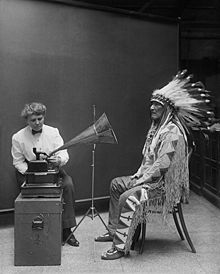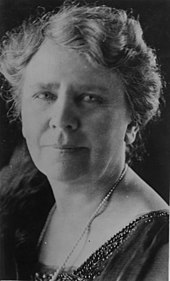Frances Densmore
Frances Theresa Densmore (born May 21, 1867 in Red Wing , Minnesota ; † June 5, 1957 ibid) was an American music ethnologist and ethnologist whose work made an important contribution to the preservation of the culture of the North American Indians .
Life
Densmore's interest in Indian music was awakened in her childhood. In an autobiographical manuscript she wrote: “My childhood home was near the banks of the Mississippi . Across from town, on an island, was a camp of Sioux Indians, and at night when they were dancing we could hear the sound of the drum and see the flickering of their campfires. [...] At dusk I listened to these sounds after I was put to bed. [...] So I fell asleep with my head full of fantasies about the 'interesting people' beyond the Mississippi. "
As a child of musically educated parents, she learned piano and harmony at an early age. From 1884 to 1886 she studied music at the Oberlin Conservatory in Ohio . After working for some time as a music teacher and church organist in St. Paul and Red Wing, she began studying piano with Karl Baermann and counterpoint with John Knowles Paine at Harvard University in Boston in 1888 .
During her stay in Boston, she learned about the field research work of Alice Cunningham Fletcher (1838-1923), which it carried out with the Omaha Indians from 1880 to research the music and customs of this tribe. Fletcher's book "A Study of Omaha Indian Music", published in 1893, became a powerful inspiration for Densmore's own field research. In 1893, under Fletcher's guidance, Densmore began a ten-year preparatory phase for her later research. During this time she continued to give music lessons and gave lectures on musicological topics, from 1895 also on Indian music.
The world exhibition Saint Louis World's Fair , also known as the Louisiana Purchase Exposition , which took place in St. Louis in 1904 , gave her the opportunity to get to know the music of the Filipino ethnic groups gathered in a "Filipino reservation". Among them were groups from the Igorot and Aeta from the island of Luzon , whose music was little known until then. Densmore's interest was in the search for the origins of music, in keeping with the current trends of the time. The Aeta assessed them as "one of the most primitive tribes on the islands" and classified them and the other groups in the first four musical stages of development so called. This biological-evolutionary assessment, today rejected as racist, expressed by Densmore on the basis of her practical knowledge, formed the justification for colonization by the United States, just like the theoretical considerations of other researchers.
In 1905 she undertook a first research trip to the Chippewa - Reserve of Grand Portage . There she transcribed songs by ear. As early as 1904 she had met the famous Apache chief Geronimo at the world exhibition and had transcribed songs by ear that he sang there. In 1907 she recorded Indian songs for the first time using a borrowed phonograph . After presenting the results of these initial field studies to the director of the Bureau of American Ethnology (BAE) at the Smithsonian Institution , she received financial support from the BAE to purchase a phonograph. This began a collaboration between the BEA and Densmore that would last 50 years until her death.
Densmore remained unmarried and devoted her entire life to studying the Indian cultures of North America.
plant

In the following years and decades she undertook almost 80 research trips to Indian reservations of various tribes - always accompanied by her sister Margaret since 1912. With the help of interpreters she recorded countless stories about the traditional tribal life of the various Indian peoples and with her phonograph she recorded a total of around 2500 songs of the Indians. The tribes she visited included the Chippewa , Sioux , Northern Ute , Mandan , Hidatsa , Tule, Papago , Pawnee , Menominee , Yuma , Yaqui , Cheyenne , Arapaho , Nootka, Quileute , Choctaw , Seminole, and Zuñi . She continued her field research until shortly before her death at the age of 90.
The results of their work have been the subject of numerous publications, more than 30 of them in book form, some of these books appeared as so-called "bulletins" of the Bureau of American Ethnology. Densmore believed that there is more to preserving Indian songs than winding up the phonograph . For this reason she gathered all the information that was necessary to understand the music of the Indians in their respective cultural context. In addition, she not only photographed her Indian informants, but also numerous ceremonial and everyday objects. For this reason, her studies contain numerous ethnographic details about everyday life, culturally significant objects, customs and religious ceremonies as well as about the musical instruments used, the biographies of the singers and the application of music. The lyrics of the songs were very important to her. Their studies on the connection between music and medicine among the Indians also took a large part, as did the healing arts of the Native Americans in general, including their herbalism.
Densmore has always had the greatest respect for the cultures which they investigated. In this way she succeeded in gaining the trust of the Indians, who often disclosed knowledge that was considered sacred and secret to her. The very old Lakota chief Śiya'ka of the Standing Rock Reservation, after telling her his dream visions and singing the accompanying songs, was deeply touched and said that he had given Densmore his best-kept property. In a lecture she gave to the Anthropological Society of Washington in April 1913 on the Sioux Sun Dance, Frances Densmore shared the initial reluctance of another old Lakota, Ituŋ'kasaŋ-lu'ta (Red Weasel): He came very much reluctantly. He had traveled forty-three miles in a wagon and when he arrived he accepted the tobacco I offered him. He said that it wasn't his wish to come and that he didn't want to tell me anything. He said that the knowledge of the sun dance was very sacred to him and that he intended that it should die with him. But she also gained this man's trust and received extremely valuable information about the sun dance from him .
In the 1940s, Frances Densmore began rearranging the audio she had recorded. In 1948 the recordings began to be dubbed onto records, and between 1951 and 1953 the Library of Congress, Washington DC, published seven records with songs from various Indian peoples in a selection made by Densmore himself. Your audio recordings are now in the American Folklife Center at the Library of Congress .
Some of her books have seen several new editions, in particular her works on the music and customs of the Chippewa and her work "Teton Sioux Music", the results of their three-year collaboration (1911-1913) with Lakota des Standing Rock Rersvats and Dakota des Sisseton - Contains reserve. "Teton Sioux Music", published for the first time in 1918, is considered to be "one of the most important ethnographic works ever published on the Sioux" (Raymond DeMallie, editor of vol. 13 of the Handbook of North American Indians ).
In addition to their cultural and historical importance, their works give Indians living today the opportunity to continue or to revive almost lost traditions and customs. Lakota musician Earl Bullhead said in a radio interview that the Densmore record "is like a seed, and that seed is now growing in many people of my age and elderly."
Fonts
- Teton Sioux Music . Washington 1918 ( at Internet Archive ; German: The songs of the old Lakota: Life and culture of the Teton-Sioux . Rosewood, Chemnitz 2012, ISBN 978-3-938305-20-1 )
- The American Indians and Their Music . New York 1926
- Yuman and Yaqui Music. Washington 1932
- Nootka and Quileute Music. Washington 1939 (Forgotten Books, 2017)
- Music of Acoma, Isleta, Cochiti, and Zuni Pueblos. Washington 1957
literature
- Frank Elstner: I heard an Indian drum. The ethnologist Frances Densmore as the guardian of Indian cultural assets . Essay. Palisander Verlag, Chemnitz 2015. ISBN 9783957840202 (ePub); ISBN 9783957840219 (MobiPocket)
- Uta Gacs, Aisha Khan, Jerrie McIntyre, and Ruth Weinberg (Eds.): Women Anthropologists: A Biographical Dictionary . Greenwood Press, New York 1988, pp. 51-57
- Charles Hofmann (Ed.): Frances Densmore and American Indian music: a memorial volume. 1968 ( digitized version )
Web links
Individual evidence
- ↑ Frances Densmore: I Heard an Indian Drum. Undated five-page autobiographical manuscript. Frances Densmore Papers, National Anthropological Archives, Suitland, MD.
- ^ Krystyn R. Moon: The Quest for Music's Origin at the St. Louis World's Fair: Frances Densmore and the Racialization of Music. In: American Music, Vol. 28, No. 2, Summer 2010, pp. 191–210, here pp. 199, 202
- ^ David Swenson: Speed Variations in the Frances Densmore Recordings. ( Memento of the original from February 5, 2016 in the Internet Archive ) Info: The archive link was inserted automatically and has not yet been checked. Please check the original and archive link according to the instructions and then remove this notice. makochevision.com
- ↑ http://glenngouldproject.blogspot.com/2011/12/pioneering-women-ethnomusicologists_05.html ( Memento from March 26, 2012 in the Internet Archive )
- ^ Hofmann, C .: Frances Densmore and American Indian Music. A memorial volume. Contribution from the Museum of the American Indian. Heye Foundation. New York 1968.
- ^ Densmore, F .: Teton Sioux Music. Washington 1918. p. 188.
- ^ Frances Densmore Papers, National Anthropological Archives.
- ↑ http://www.amazon.de/Teton-Sioux-Culture-Frances-Densmore/dp/080326593X
- ↑ (Minnesota Public Radio, 1994 - http://americanradioworks.publicradio.org/features/densmore/docs/radiodoc1.shtml )
| personal data | |
|---|---|
| SURNAME | Densmore, Frances |
| ALTERNATIVE NAMES | Densmore, Frances Theresa (full name) |
| BRIEF DESCRIPTION | American ethnomusicologist |
| DATE OF BIRTH | May 21, 1867 |
| PLACE OF BIRTH | Red Wing , Minnesota |
| DATE OF DEATH | 5th June 1957 |
| Place of death | Red Wing , Minnesota |
